Awareness
Published: June 17, 2013; updated: October 3, 2013
These exercises will help you build awareness of cars around you. They are meant to be performed in regular street or highway driving.
You should first review the vision exercises because without vision there can be no awareness.
Prioritizing Vehicles
Suppose you are driving a car and you are following a car which in turn is following a semi. Is your speed going to be dictated by the car in front of you or by the semi in front of that car?
When you are driving in traffic, you typically should watch the cars that have large following distances, as they will dictate when you will need to slow down. After you start braking you can move your attention to the tailgaters to see how close they come to rear-ending the vehicles in front of them.
Evasion Options
Many drivers have just one tool in their arsenal when it comes to emergencies: brakes. Unfortunately, brakes can only do so much. It pays to have other tools.
Most highways have shoulders. While driving on a highway, make a note of whether you can use the left or the right shoulder, depending on which lane you are in, to avoid debris in your lane on a suddenly stopping vehicle.
If you have been working on your peripheral vision and looking ahead, you will also be able to use other traffic lanes for evasion based on your best estimate of whether they are free or occupied at the instant needed.
Planning Ahead
Some people have a direct connection between their brain and the brake pedal in their car. Some examples where this is demonstrated:
- A car is approaching an exit sign. The driver taps the brakes as they are reading the sign, even if the exit is a mile down the highway.
- A car is approaching another car in an adjacent lane. The driver taps the brakes even though their own lane is clear.
What happens is these drivers spend most of their driving time paying absolutely no attention to the road. When they get to a sign or a car they are completely unaware of where they are, therefore they start with their standard defensive mechanism of hitting the brakes. These drivers do not brake because they need to slow down; they brake because they are thinking. A driver who pays even moderate attention to the road would be able to process their surroundings while maintaining their speed.
Another example: cars A and B are traveling in the right lane of a two lane highway with no other cars nearby. Car B is catching car A. As car B approaches car A, car B hits the brakes, decelerates to car A's speed, then changes lanes and passes car A.
Lacking any other cars in the vicinity, car B could have planned to pass car A way before getting to car A's rear bumper.
Lane Change Discipline
Most people are, for lack of a better term, afraid to wait to change lanes. A diagram should explain it better:
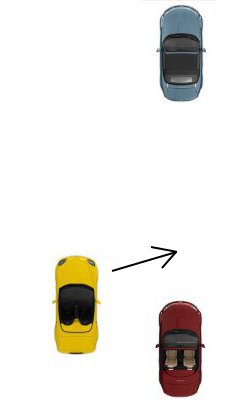 |
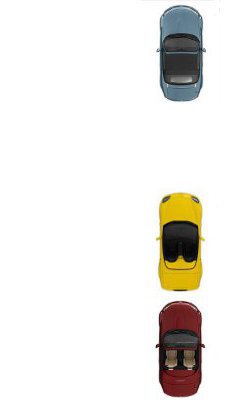 |
The yellow car wants to slot between blue and red cars. However, the driver is afraid to wait another two seconds and move in the middle, and instead is much closer to the red car than they are to the blue car.
The correct way of doing this lane change is to wait a little longer and move in the middle between the cars:
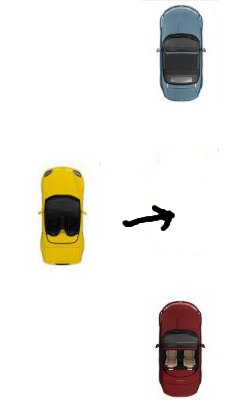 |
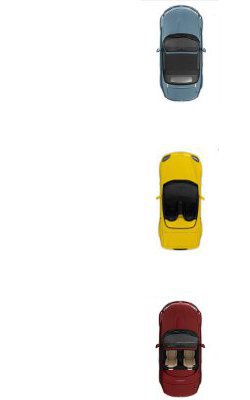 |
Part of being able to do this, besides patience, is watching two cars at the same time, one being in front of you and one being behind you.
The same situation applies when the blue car is not there and it is just the yellow car passing the red car. A lot of the time street drivers in the equivalent of the yellow car pinch the red car when there is nobody in front of them at all.
This exercise directly translates into correct passing at HPDE events.
Braking
If you know you have to brake, do you account for the car behind you? You should as chances are the driver behind is only watching you and not traffic in front of you. If you are followed closely by another car, you don't want to slam on the brakes as late as possible - while you could stop in time, the driver behind is likely to plow into you.
Starting to brake early, and braking gently, is especially important if the vehicle following you is much heavier than you are, e.g. if you are driving a car and are followed by a semi. Similar reasoning applies to reduced traction conditions such as rain and snow.
Note: most street drivers do not brake hard unless they are about to drive into someone. The difference between the you and such drivers is you make a conscious decision to apply a certain amount of braking pressure based on cars around you whereas they are only able to brake in one way.
Avoiding Excessive Acceleration
You probably saw this happening:
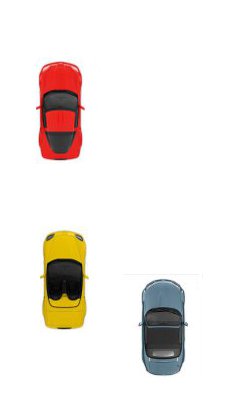 |
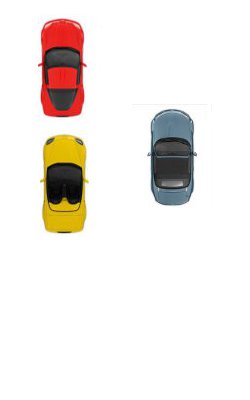 |
The red car is a perpetual left lane rider. The blue car is passing the red and the yellow cars on the right. As the blue car passes the yellow car, the yellow car starts to accelerate to keep ahead of the blue car. However, all that leads to is the yellow car hitting the brakes two seconds later as it is about to drive into the red car in front that is still unaware of the blue car existing.
The yellow car's driver needs to be more aware of the red car in front and not try to accelerate when they have nowhere to go.
A variant of this exercise is driving between traffic lights in a city. There is little reason to race light to light when gentler acceleration and braking will do the job just fine.
Tagged: intermediate
 Visit our
Visit our